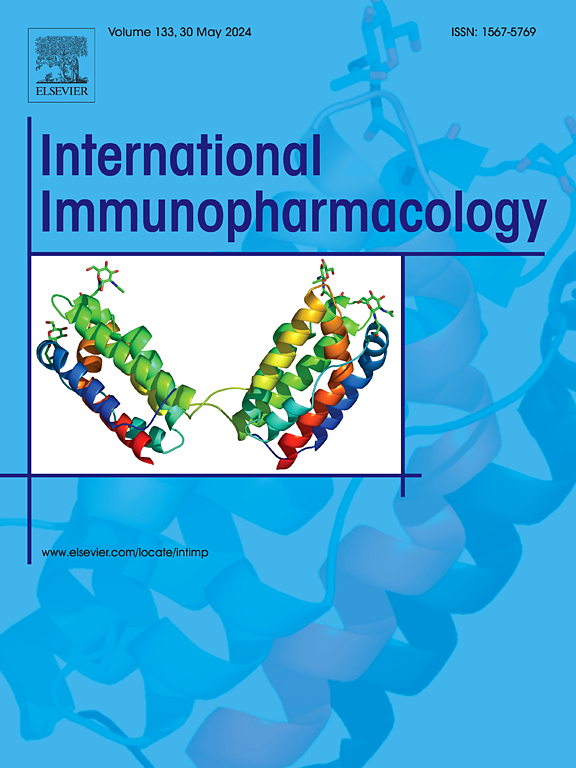MIA和CD163作为血管性痴呆的有希望的诊断生物标志物:一项结合WGCNA、机器学习和动物模型和临床样本验证的多方法研究
IF 4.7
2区 医学
Q2 IMMUNOLOGY
引用次数: 0
摘要
血管性痴呆(VaD)是第二种最常见的痴呆形式,缺乏可靠的早期诊断生物标志物。在这里,我们将加权基因共表达网络分析(WGCNA)与机器学习相结合,以识别VaD中新的生物标志物和免疫代谢途径。对GSE122063数据集进行分析,发现288个差异表达基因(DEGs),其中4个中心基因(MIA, CD163, OPALIN, SNX31)通过LASSO回归和随机森林进行优先排序。纳入这些基因的nomogram模型的AUC为0.924,显示出较高的诊断准确性。外部验证(GSE186798)和实验研究证实了VaD患者和2VO大鼠模型中MIA和CD163的显著上调(P <;0.05),而SNX31与OPALIN的差异无统计学意义。在机制上,MIA和CD163与巨噬细胞极化(M1/M2)和氧化磷酸化通路失调相关,表明它们在神经炎症和代谢重编程中具有双重作用。血清ELISA进一步证实VaD患者MIA(14.34±6.32 vs. 5.23±4.89 ng/mL)和CD163(141.31±71.27 vs. 58.09±54.31 ng/mL)升高(P <;0.05)。我们的研究不仅确立了MIA和CD163作为强有力的诊断生物标志物,而且强调了它们作为调节VaD发病机制中免疫代谢串音的治疗靶点的潜力。本文章由计算机程序翻译,如有差异,请以英文原文为准。
MIA and CD163 as promising diagnostic biomarkers in vascular dementia: A multi-method study combining WGCNA, machine learning with validation in animal models and clinical samples
Vascular dementia (VaD), the second most common form of dementia, lacks reliable biomarkers for early diagnosis. Here, we integrated weighted gene co-expression network analysis (WGCNA) with machine learning to identify novel biomarkers and immune-metabolic pathways in VaD. Analysis of the GSE122063 dataset revealed 288 differentially expressed genes (DEGs), with four hub genes (MIA, CD163, OPALIN, SNX31) prioritized by LASSO regression and Random Forest. A nomogram model incorporating these genes achieved an AUC of 0.924, demonstrating high diagnostic accuracy. External validation (GSE186798) and experimental studies confirmed significant upregulation of MIA and CD163 in VaD patients and a 2VO rat model (P < 0.05), while SNX31 and OPALIN showed inconsistent significance. Mechanistically, MIA and CD163 correlated with macrophage polarization (M1/M2) and dysregulated oxidative phosphorylation pathways, suggesting their dual roles in neuroinflammation and metabolic reprogramming. Serum ELISA further validated elevated MIA (14.34 ± 6.32 vs. 5.23 ± 4.89 ng/mL) and CD163 (141.31 ± 71.27 vs. 58.09 ± 54.31 ng/mL) in VaD patients (P < 0.05). Our study not only establishes MIA and CD163 as robust diagnostic biomarkers but also highlights their potential as therapeutic targets for modulating immune-metabolic crosstalk in VaD pathogenesis.
求助全文
通过发布文献求助,成功后即可免费获取论文全文。
去求助
来源期刊
CiteScore
8.40
自引率
3.60%
发文量
935
审稿时长
53 days
期刊介绍:
International Immunopharmacology is the primary vehicle for the publication of original research papers pertinent to the overlapping areas of immunology, pharmacology, cytokine biology, immunotherapy, immunopathology and immunotoxicology. Review articles that encompass these subjects are also welcome.
The subject material appropriate for submission includes:
• Clinical studies employing immunotherapy of any type including the use of: bacterial and chemical agents; thymic hormones, interferon, lymphokines, etc., in transplantation and diseases such as cancer, immunodeficiency, chronic infection and allergic, inflammatory or autoimmune disorders.
• Studies on the mechanisms of action of these agents for specific parameters of immune competence as well as the overall clinical state.
• Pre-clinical animal studies and in vitro studies on mechanisms of action with immunopotentiators, immunomodulators, immunoadjuvants and other pharmacological agents active on cells participating in immune or allergic responses.
• Pharmacological compounds, microbial products and toxicological agents that affect the lymphoid system, and their mechanisms of action.
• Agents that activate genes or modify transcription and translation within the immune response.
• Substances activated, generated, or released through immunologic or related pathways that are pharmacologically active.
• Production, function and regulation of cytokines and their receptors.
• Classical pharmacological studies on the effects of chemokines and bioactive factors released during immunological reactions.

 求助内容:
求助内容: 应助结果提醒方式:
应助结果提醒方式:


